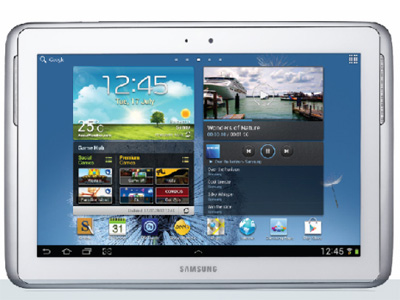Samsung Galaxy Note 10.1 Has Bigger Profit Margin Than iPad
More than two years after the introduction of the iPad, Samsung appears to be very confident in the tablet market and is shooting for margins that exceed Apple's iPad levels.
According to IHS, the HSPA+-equipped Galaxy Note 10.1 has a bill of materials (BOM) of $283, excluding assembly cost. The device sells for about $640 to consumers.
The Wi-Fi only $499 Galaxy Note 10.1 has a BOM of $260. In comparison the 16 GB, Wi-Fi only iPad as an estimated BOM of $316. At least in theory, Samsung can make more money per device than Apple does.
“With the Galaxy Note 10.1, Samsung continues to seek the magic formula for a media tablet that can rival the iPad’s market penetration,” said IHS' Andrew Rassweiler. “And where some other tablets introduced in recent times generated small or no hardware profit, the Galaxy Note 10.1 could turn a decent per unit margin for Samsung, and stands to be a money maker, if the company can extend the recent success of the Samsung Galaxy Note smartphone to its tablet line.”
Rassweiler noted that the Google Nexus 7 and the Amazon Kindle Fire generated "little or no hardware profit". Obviously, the actual profit will lie in demand - and Samsung still has to show that it can sell the tablet in substantial numbers, which will help sustain the current retail pricing. At this time, there hard no substantial discounts available for the Galaxy Note 10.1.
“Samsung is a behemoth in the electronic industry and its competitive strength lies in its control, via internal sourcing, of a large percentage of the components that go into its final products,” Rassweiler said. “This allows Samsung to keep costs down, while delivering competitive differentiation. The company’s internal sourcing strategy is certainly in evidence in the Galaxy Note 10.1, where Samsung supplies the memory, both flash and DRAM, as well as the core processor, battery and many other components.”
IHS said that, compared to its predecessor, the Galaxy Note 10.1 only has an incremental set of improvements.
Contact Us for News Tips, Corrections and Feedback
Get Tom's Hardware's best news and in-depth reviews, straight to your inbox.

Wolfgang Gruener is an experienced professional in digital strategy and content, specializing in web strategy, content architecture, user experience, and applying AI in content operations within the insurtech industry. His previous roles include Director, Digital Strategy and Content Experience at American Eagle, Managing Editor at TG Daily, and contributing to publications like Tom's Guide and Tom's Hardware.
-
subaru41 nieurwill apple sue them for infringing profit margin?LOL!Reply
No, but Apple will come out with a product or software called iNote and sue Samsung for copying name and trade dress of using white, because apple invented the color white on the first iPad.
-
tomfreak Apple Ipad is priced more aggressively compared to their crappy overprice Mac/iphone. There is no reason for a smaller screen Iphone 4s using the crappier A5 non-X CPU with a smaller battery pack to cost more than Ipad3. Those who buy Iphone 4S is getting rip off for good.Reply -
dauntekong TomfreakApple Ipad is priced more aggressively compared to their crappy overprice Mac/iphone. There is no reason for a smaller screen Iphone 4s using the crappier A5 non-X CPU with a smaller battery pack to cost more than Ipad3. Those who buy Iphone 4S is getting rip off for good.Reply
"Ba dee Ba dee Ba dee, That's Apple for you folks!" Said Porkie pig. -
ikyung It only makes sense Samsung will have a bigger profit margin. They pretty much make every single component that goes inside.Reply
I noticed Samsung's current trend is, keep pricing the same as competitors while being about 2 quarters ahead in technology. Now, if Samsung can invest big money into a software developing sector, they can maybe turn their current OS into a big competitor against Android, iOS, and W8.. but, I've only seen Samsung's OS on Korean phones and some European Samsung phones. And it's pretty crappy from what I heard.
If Samsung can make their OS lightweight as iOS and open as Android, I would definitely see it dominating the market. -
schnitter dauntekongCheaper, better, and lighter. Samsung takes the lead even after losing the lawsuitSo Apple spend moreReply
Getting a bigger profit off the consumers is hardly a win now is it?
Wasn't all the hating on Apple about them being overpriced and yet Samsung openly announce they are taking more money per customer than apple? And yet you praise them for this?
Oh the irony. -
mike_man Personally I love Samsung, but bragging about profit margin is not the way to go! Besides clearly the 10" Note is going to sell a lot less than the iPad so that isn't going to count for much.Reply
